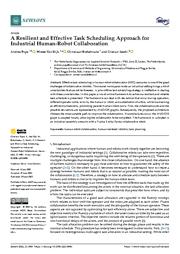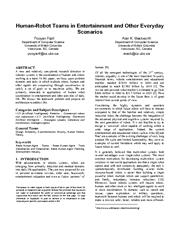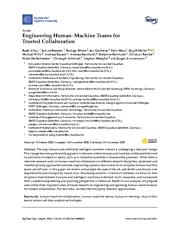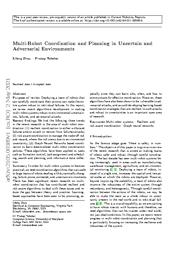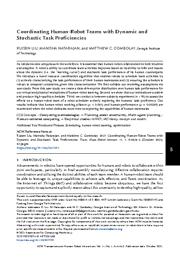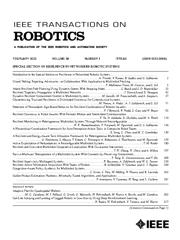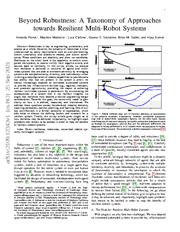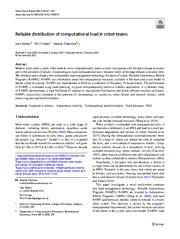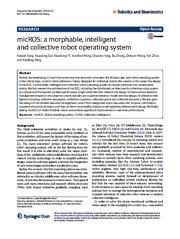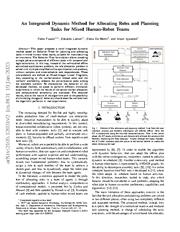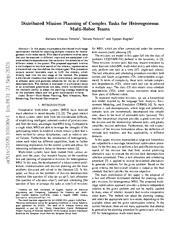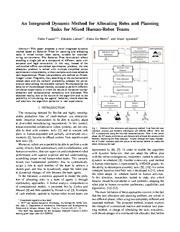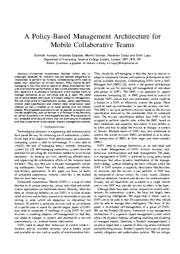A copy of this work was available on the public web and has been preserved in the Wayback Machine. The capture dates from 2022; you can also visit the original URL.
The file type is application/pdf.
Filters
A Resilient and Effective Task Scheduling Approach for Industrial Human-Robot Collaboration
2022
Sensors
If some failures occur, the AND/OR graph is adapted locally, allowing the collaboration to be completed. ...
Effective task scheduling in human-robot collaboration (HRC) scenarios is one of the great challenges of collaborative robotics. ...
For this reason, each task T i is associated with recovery actions that allow to restore the nominal behavior of the human-robot team. ...
doi:10.3390/s22134901
pmid:35808396
pmcid:PMC9269759
fatcat:igdhck7iorbcffc3t3fhrr5x6y
Human-Robot Teams in Entertainment and Other Everyday Scenarios
[article]
2009
arXiv
pre-print
A new and relatively unexplored research direction in robotics systems is the coordination of humans and robots working as a team. ...
In this paper, we focus upon problem domains and tasks in which multiple robots, humans and other agents are cooperating through coordination to satisfy a set of goals or to maximize utility. ...
(a mixed human-robot team) might be needed. • Communication: Within the environment, effective communication from robot to robot, robot to human, and human to human is needed. • Heterogeneity: The team ...
arXiv:0908.2661v1
fatcat:v5phwpiuf5ccddod6mbnovtpdi
Engineering Human–Machine Teams for Trusted Collaboration
2020
Big Data and Cognitive Computing
Based on our analysis, we propose and outline three important areas of future research on engineering and operating human–machine teams for trusted collaboration. ...
This change becomes particularly apparent in domains where humans and machines collaboratively work on joint tasks or objects in teams, such as in industrial assembly or disassembly processes. ...
Acknowledgments: We gratefully acknowledge Alexander Herzog, Carsten Hesselmann and Marc Schlegel for providing administrative support of the HERMES project. ...
doi:10.3390/bdcc4040035
fatcat:uoanpxph5fbglo7sl3pytbkykm
Data Survivability in Networks of Mobile Robots in Urban Disaster Environments
[article]
2013
arXiv
pre-print
Our technique considers the anticipated robot failures and robot heterogeneity to decide how aggressively to replicate data. ...
Using our novel simulation generation frameworks, we compare our adaptive technique with flooding and broadcast-based replication techniques and show that for failure rates of up to 60% it ensures better ...
First, these solutions assume homogeneous nodes, while robot teams may be heterogeneous, with different capabilities and failure rates. ...
arXiv:1210.6382v2
fatcat:pvh3ksq5t5e7lb6iqciixo6a7u
Multi-Robot Coordination and Planning in Uncertain and Adversarial Environments
[article]
2021
arXiv
pre-print
In order for multi-robot systems to become practical, we need coordination algorithms that can scale to large teams of robots dealing with dynamically changing, failure-prone, contested, and uncertain ...
Deploying a team of robots that can carefully coordinate their actions can make the entire system robust to individual failures. ...
Acknowledgements The authors would like to thank the National Science Foundation (NSF IIS-1637915) and the Office of Naval Research (ONR N00014-18-1-2829) for their supports. ...
arXiv:2105.00389v1
fatcat:bwnyxvpvzjfrbjxyiysnmq5e74
Coordinating Human-Robot Teams with Dynamic and Stochastic Task Proficiencies
2022
ACM Transactions on Human-Robot Interaction (THRI)
As robots become ubiquitous in the workforce, it is essential that human-robot collaboration be both intuitive and adaptive. ...
Third, we conduct a between-subjects experiment (n = 90) to assess the effects on a human-robot team of a robot scheduler actively exploring the humans' task proficiency. ...
To accomplish successful human-robot interation (HRI) and collaboration with improved performance and team alliance, we develop computational methods to determine high-quality schedules and adaptions to ...
doi:10.1145/3477391
fatcat:p3zsytzqhnhitbdde2az6naxk4
Table of Contents
2022
IEEE Transactions on robotics
Sukhatme 2 Crowd Vetting: Rejecting Adversaries via Collaboration With Application to Multirobot Flocking . . . . . . . . . . . . . . . . . . . . . . . . . . . . . . . . . . . . . . . . . . . . . . . . ...
Tanner 229 Resilient Active Information Acquisition With Teams of Robots . . . . . . . . . . B. Schlotfeldt, V. Tzoumas, and G. J. ...
doi:10.1109/tro.2022.3145122
fatcat:mymiizwgona5bgfom327pbeufi
Beyond Robustness: A Taxonomy of Approaches towards Resilient Multi-Robot Systems
[article]
2021
arXiv
pre-print
Importantly, we highlight open problems that remain to be tackled in order to reap the benefits of resilient robotic systems. ...
multi-robot systems is paramount. ...
In [221] , the authors consider collaboration across heterogeneous robot teams; their method builds on the theory of differential privacy to quantify how easy it is for an adversary to identify the type ...
arXiv:2109.12343v1
fatcat:vxt62eluljfelcifzdlosv34cq
Reliable distribution of computational load in robot teams
2021
Autonomous Robots
AbstractModern multi-robot systems often need to solve computationally intensive tasks but operate with limited compute resources and in the presence of failures. ...
We introduce and evaluate a new computation load management technology for teams of robots: Reliable Autonomous Mobile Programs (RAMPs). ...
That is, RAMPs are the first mechanism for distributing load within robot teams that adapts to hardware and network failures. ...
doi:10.1007/s10514-021-09967-8
fatcat:wksld65s2bdblg24tnpwrvxuoy
micROS: a morphable, intelligent and collective robot operating system
2016
Robotics and Biomimetics
We present in this paper the design of micROS, a morphable, intelligent and collective robot operating system for future collective and collaborative robots. ...
Robots are developing in much the same way that personal computers did 40 years ago, and robot operating system is the critical basis. Current robot software is mainly designed for individual robots. ...
Moreover, collective robots themselves are extremely heterogeneous and suffer from high hardware and software failure rate. ...
doi:10.1186/s40638-016-0054-y
pmid:27942434
pmcid:PMC5124045
fatcat:adsh6md3ojfedcr3le47lp7v7u
An Integrated Dynamic Method for Allocating Roles and Planning Tasks for Mixed Human-Robot Teams
[article]
2021
arXiv
pre-print
This paper proposes a novel integrated dynamic method based on Behavior Trees for planning and allocating tasks in mixed human robot teams, suitable for manufacturing environments. ...
In this way, instead of the well-studied offline centralized optimization problem, the role allocation problem is solved with multiple simplified online optimization sub-problem, without complex and cross-schedule ...
of the job in a heterogeneous human-robot team. ...
arXiv:2105.12031v1
fatcat:ka7rw6o3crdo3djc4bqydjsd2y
Distributed Mission Planning of Complex Tasks for Heterogeneous Multi-Robot Teams
[article]
2021
arXiv
pre-print
In this paper, we propose a distributed multi-stage optimization method for planning complex missions for heterogeneous multi-robot teams. ...
This class of problems involves tasks that can be executed in different ways and are associated with cross-schedule dependencies that constrain the schedules of the different robots in the system. ...
Furthermore, the introduction of heterogeneity, where each robot has different capabilities, leads to further interesting implications for the control system and allows for interesting collaborative behavior ...
arXiv:2109.10106v1
fatcat:naikx3o72rgwxnvlz2cbdo3qyi
An Integrated Dynamic Method for Allocating Roles and Planning Tasks for Mixed Human-Robot Teams
2021
Zenodo
This paper proposes a novel integrated dynamic method based on Behavior Trees for planning and allocating tasks in mixed human robot teams, suitable for manufacturing environments. ...
In this way, instead of the well-studied offline centralized optimization problem, the role allocation problem is solved with multiple simplified online optimization sub-problems, without complex and cross-schedule ...
of the job in a heterogeneous human-robot team. ...
doi:10.5281/zenodo.4954950
fatcat:k3vwzo57ajgapdwlgitshtlxmy
A policy-based management architecture for mobile collaborative teams
2009
2009 IEEE International Conference on Pervasive Computing and Communications
Collaborating UAVs need to adapt their behaviour to current context. ...
They should be selfmanaging in that they have to recover or adapt to component failures and optimise performance to best utilise available resources. ...
ACKNOWLEDGEMENTS The work reported in this paper was funded by the Systems Engineering for Autonomous Systems (SEAS) Defence Technology Centre established by the UK Ministry of Defence. ...
doi:10.1109/percom.2009.4912765
dblp:conf/percom/AsmareGSDL09
fatcat:jvttztpy25d7vanay64z3ghumm
Supporting AI Planning and Collaboration for Robotic Applications Using TAEMS
2024
Proceedings of the AAAI Symposium Series
This paper describes a general approach to integrating higher-level reasoning mechanisms including planning and scheduling methods with lower-level robotic control processes. ...
This TAEMS representation language serves as the input of the reasoning functions, which generate a schedule of executable methods to be executed by the robot in the physical world. ...
An intelligent scheduler and a collaboration toolkit may be developed based on TAEMS framework to generate a plan for the robot and handle necessary collaboration with other robots. ...
doi:10.1609/aaaiss.v2i1.27726
fatcat:tqrhkigzave4xjbvhzckzcz4cm
« Previous
Showing results 1 — 15 out of 4,781 results

